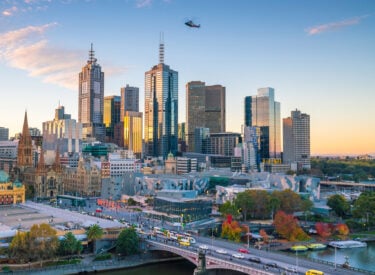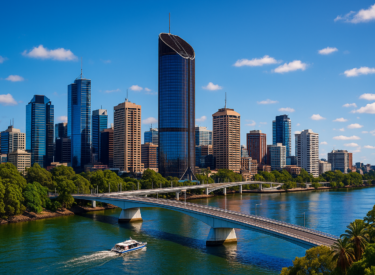
Key takeaways
Australia's population is expected to grow to over 40 million by 2063, with migration continuing to be the primary driver of growth. However, the source of this migration is set to change, with the bulk of new arrivals coming from Asia.
The aging population will require more support in healthcare and aged care services to ensure Australians can enjoy a high quality of life well into their later years. The impact of an aging population on the economy and society will be felt over the coming decades. The proportion of people in the workforce will decrease, putting additional strain on those who are working, and increasing the demand for healthcare and aged care services.
As Australia's population grows, so too will its cities. The urban landscape in 2063 will be markedly different from what we see today, with more Australians choosing to live in apartments, townhouses, and other forms of medium and high-density housing.
The way we build homes will change, moving away from traditional, labour-intensive methods towards more efficient, factory-based production. Prefabricated housing will become increasingly common, and "whole-of-life dwellings" will gain traction, designed to be adaptable as residents' needs change over time.
The Australia of 2063 will be very different from the country we know today. By understanding the trends and preparing for the changes ahead, Australia can position itself to thrive in the coming decades.
Australia is poised for a period of significant transformation, and the latest Intergenerational Report gives us a glimpse into what the country might look like in 2063.
As we consider the long-term future, it becomes clear that these projections are not merely theoretical—they have real implications for investors, business leaders, policymakers, and everyday Australians.
Understanding these trends is crucial if we are to navigate the challenges and seize the opportunities that lie ahead.
For weekly insights and strategic advice, subscribe to the Demographics Decoded podcast, where we will continue to explore these trends and their implications in greater detail.
Subscribe now on your favourite Podcast player:
Population growth and demographic shifts
One of the most striking projections in the report is the anticipated growth in Australia’s population.
Currently sitting at around 27 million, the population is expected to swell to over 40 million by 2063.
While this growth will be slower than in past decades, it remains significant, especially considering the shifting demographics accompanying it.
Migration will continue to be the primary driver of population growth, contributing to two-thirds of the increase.
However, the source of this migration is set to change.
In the post-war period, Australia welcomed large numbers of European migrants, particularly from Italy and Greece.
These were young, often unskilled workers who played a crucial role in building the nation’s infrastructure.
Today, Europe’s aging population means it is no longer a significant source of migrants.
Instead, the bulk of new arrivals will come from Asia, bringing with them different cultural backgrounds and perspectives.
This will inevitably reshape Australia's social and cultural fabric.
But with this growth comes a challenge.
Our population is not only increasing in size—it’s also getting older.
Australians are living longer and spending more years in good health, a trend that is expected to continue.
While this is undoubtedly positive, it also means that the country will need to invest more in healthcare and aged care services.
The aging population will require more support, both in terms of physical infrastructure and social services, to ensure that Australians can enjoy a high quality of life well into their later years.
Urbanization and the evolution of our cities
As Australia’s population grows, so too will its cities.
The urban landscape in 2063 will be markedly different from what we see today.
The major capitals—Sydney, Melbourne, and Brisbane—will continue to expand, but not in the sprawling, suburban fashion of the past.
Instead, we will see a shift towards higher-density living, with more Australians choosing to live in apartments, townhouses, and other forms of medium and high-density housing.
This densification is partly a response to the constraints of space and the need for more sustainable urban development.
Large backyards will become a rarity as more people trade outdoor space for the convenience of urban living.
This doesn’t mean a lower quality of life; rather, it reflects a shift in lifestyle preferences, where proximity to work, amenities, and social activities outweighs the desire for expansive personal space.
The way we build these homes will also change.
The construction industry is expected to undergo a significant transformation, moving away from traditional, labour-intensive methods towards more efficient, factory-based production.
Prefabricated housing, where components are manufactured off-site and then assembled on location, will become increasingly common.
This method not only reduces construction time and costs but also minimises waste, making it a more sustainable option.
Moreover, as our cities grow denser, the concept of “whole-of-life” dwellings will gain traction.
These are homes designed with the future in mind, built to be adaptable as residents’ needs change over time.
For example, wider doorways and accessible bathrooms that can be easily modified for mobility needs will become standard features, allowing people to age in place without the need for costly renovations.

Economic transformation and challenges
Australia’s economy is set to grow significantly over the next 40 years, with the Intergenerational Report projecting that it will be 2.5 times larger by 2063.
Real incomes are expected to be around 50% higher, but this growth will likely be slower than in previous decades.
This is partly due to the anticipated global economic environment and partly because of the structural changes within the Australian economy itself.
Historically, Australia’s economy has been heavily reliant on natural resources—particularly mining and agriculture.
These industries will continue to play a crucial role, but their nature will evolve.
For example, while coal has been a major export for decades, the global shift towards decarbonization will reduce its importance.
Instead, demand will grow for minerals like lithium and nickel, which are essential for renewable energy technologies such as batteries.
This shift presents both opportunities and challenges.
On the one hand, Australia is well-positioned to become a leader in the production of these critical minerals.
At the same time, the decline in revenue from traditional sources such as coal and fuel excises will force the government to rethink its revenue strategies.
The report suggests that the tax base will need to be broadened, possibly through new forms of taxation or higher rates on existing taxes.
This could have significant implications for both businesses and individuals.
Productivity will also be a key factor in Australia’s future economic success.
The report assumes a modest increase in productivity growth, but this is by no means guaranteed.
The rapid advancement of AI, automation, and robotics could dramatically reshape the workforce, making some jobs obsolete while creating new opportunities in other areas.
Businesses that are quick to adapt to these changes, investing in new technologies and rethinking their operations, will be better positioned to thrive.

The impact of an aging population
One of the most profound challenges Australia will face in the coming decades is the impact of an aging population on the economy and society.
As the population ages, the proportion of people in the workforce will decrease, putting additional strain on those who are working.
This could lead to a slowdown in economic growth, as there will be fewer workers available to drive productivity.
The aging population will also increase the demand for healthcare and aged care services.
The report predicts that spending on these services will rise significantly, creating a financial burden for both governments and individuals.
At the same time, the nature of retirement is changing.
The traditional model of retiring at 65 and living off a pension is becoming less common.
Instead, more Australians are choosing to transition gradually into retirement, reducing their work hours rather than stopping work altogether.
This shift will require changes to the way retirement savings and pensions are structured, with greater flexibility needed to accommodate diverse retirement paths.
The future of housing
Housing will be a central issue for Australia over the next 40 years.
The combination of a growing population, increased urbanization, and an aging demographic will put pressure on the housing market, particularly in the major cities.
As demand for housing rises, affordability will become an even more pressing concern than it is today.
The report suggests that innovation in housing construction could help alleviate some of these pressures.
Prefabricated and modular housing, which can be built more quickly and cheaply than traditional homes, could become more widespread.
These homes are also more sustainable, producing less waste and using fewer resources, which will be increasingly important as environmental concerns take centre stage.
Another trend likely to gain traction is the development of mixed-use neighbourhoods that combine residential, commercial, and recreational spaces. These areas will provide residents with easy access to everything they need, reducing the need for long commutes and making urban living more attractive.
For investors, this trend presents opportunities to invest in developments that are not only profitable but also contribute to creating vibrant, sustainable communities.
Innovation and productivity: the keys to future success
As Australia looks ahead to 2063, it is clear that innovation and productivity will be critical to the country’s success.
The report highlights the need for increased investment in technology and infrastructure to drive economic growth and maintain competitiveness on the global stage.
AI and automation, in particular, are set to revolutionise industries across the board.
While this will inevitably lead to job displacement in some sectors, it also presents opportunities for businesses to increase efficiency and productivity.
Those who embrace these changes and invest in new technologies will be better positioned to capture market share and grow their businesses.
The government will also play a crucial role in fostering innovation.
Policies that encourage investment in research and development, support for startups, and incentives for businesses to adopt new technologies will be essential.
Additionally, as the report suggests, there will be a need for new revenue streams to replace declining income from traditional sources.
This could involve a shift towards more progressive taxation, where wealthier individuals and corporations pay a larger share of taxes.
The role of migration in Australia’s future
Migration will continue to play a pivotal role in Australia’s future.
The report suggests that by 2063, migration will account for a significant portion of the country’s population growth.
This is not only necessary to fill labour shortages but also to maintain a diverse and dynamic society.
However, the nature of migration is changing.
As the global population ages, there will be increased competition for young, skilled workers.
Australia will need to remain an attractive destination for migrants, offering not only economic opportunities but also a high quality of life.
This means addressing issues such as housing affordability, healthcare, and education to ensure that Australia remains a top choice for migrants.
The report also highlights the importance of integrating migrants into the workforce and society.
This will require ongoing efforts to provide language and job training, as well as support for businesses that employ migrants.
By doing so, Australia can ensure that migration continues to contribute positively to the economy and society as a whole.

Conclusion: preparing for the future
The Australia of 2063 will be very different from the country we know today.
While the challenges outlined in the Intergenerational Report are significant, they also present opportunities for growth and innovation.
By understanding these trends and preparing for the changes ahead, Australia can position itself to thrive in the coming decades.
For investors, business leaders, and policymakers, now is the time to start planning for the future.
Whether it’s through investing in new technologies, adapting to changing demographics or rethinking the way we build our cities, there are steps we can take today to ensure a prosperous and sustainable future for Australia.
Stay tuned for more episodes of Demographics Decoded, where Simon and I will continue to explore the trends shaping our future.
If you found this discussion helpful, don't forget to subscribe to our podcast and share it with others who might benefit from it.
Subscribe now on your favourite Podcast player:














